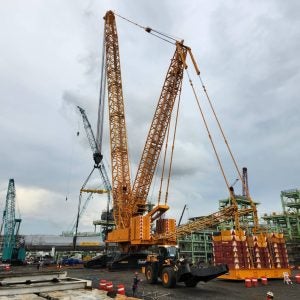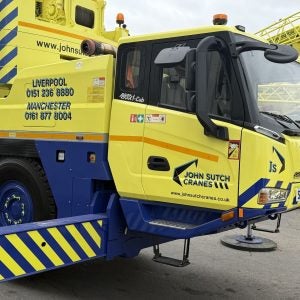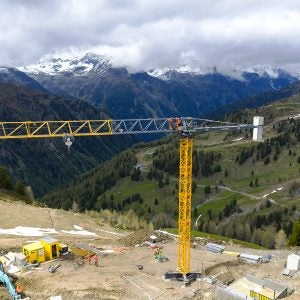Space was a challenge, but with the CC 3800-1 it was possible to set up the 84m-long main boom without a Superlift counterweight. Assisting the lattice boom crawler crane was a Demag AC 160-5 all terrain crane.
“This work site required us to lift loads of 96t to 148t at radiuses of 40m to 64m, so there was no option but to use a crawler crane in the 650t class despite the constrained space conditions,” said Wiesbauer project manager Marco Wilhelm.
Before the CC 3800-1 could be brought to the job site, its work area needed to be prepared first: “The Lahn flows right along the work site, so the ground wouldn’t have been able to bear the heavy load exerted by our machine. That’s why the work area was prepared with a concrete foundation for the crane,” Wilhelm explained.
This made it possible to safely set up the crane with an LSL 1 configuration featuring an 84m main boom, 36m Superlift boom, 50t central ballast, and 225t counterweight, with the counterweight in particular being absolutely crucial.
“The extremely heavy counterweight enabled us to set up the main boom without an additional Superlift counterweight. Moreover, this was what made it possible to use the enormous crawler crane to pick up the loads at such a tight work site, as leaving out the Superlift counterweight actually increased the crane’s usable working area significantly,” Wilhelm said. In fact, the Superlift counterweight was not needed until later during the lift.
Once the preparation work was done, the Wiesbauer team was ready to carry out all the lifts with the Demag CC 3800-1. In order to build the two bridge sections, it was necessary to perform the work in two different steps at two different work areas.
The steel components had to be lifted over the Lahn river in one step, and over a parallel rail line in the other. In each step of the project, one steel cross beam and four longitudinal steel girders had to be put into position. All these lifts followed the same pattern: Due to the space limitations, the Demag CC 3800-1 crane picked up the steel beams—which were up to 54m long and weighed 96 to 148t—from the SPMT units without a Superlift counterweight.
The crane then slew to a pick-up point where it would be possible to attach the ready-to-go Superlift counterweight frame and its counterweight of 325t to the Demag CC 3800-1 so that it would be able to work in bigger radii, lift the beams to a height of around 22m, and then set them down at the intended bridge points. The radii ranged from 40 to 64m. And due to their length, the beams were rigged to 20 and 25m-long spreader beams that made it possible to achieve the required precision for the lifts.
One of the priorities during the project was to minimize its impact on rail traffic, which is why the Wiesbauer team had to perform most of the lifts at night within very tightly defined time windows during which rail traffic paused. Despite these tight time windows and space conditions, however, the team was able to successfully complete both steps in a mere five weeks.






